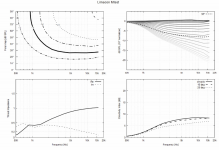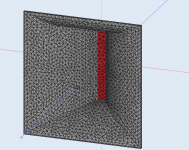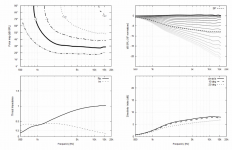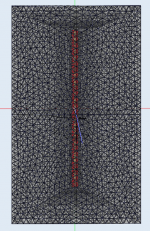Only a bit to do with ATH: I am more familiar with abec and wanted to simulate a 2 way now with a circsim generated ATH profile. The project runs fine in Abec but importing the file in Akabak leads to issue "size zero in component....". Strange: even if I copy the nodes by hand and set up a new project the issue remains. Something wrong with circsym mode perhaps? Usually use 3D Mode....
Sounds like there's a line segment with both ends on the axis of rotation (which is not correct).
vineethkumar01 - Thanks, those are really good results.
vineethkumar01 - Thanks, those are really good results.
Yes, it should be possible now (haven't checked for a while):
https://www.diyaudio.com/community/...-design-the-easy-way-ath4.338806/post-7046022
https://www.diyaudio.com/community/...-design-the-easy-way-ath4.338806/post-7046022
Hi Marcel
More and more I learn about influence of the single paramters. Unfortunately I habe to try around with round horn shapes to keep sim time low for faster learning. The dcx464 is now here waiting 🙂
The rectangular horns need several minutes to solve so I am not so fast in optimizing. Whatever I try starting from your post 10653 I cannot get same quality as you in
https://www.diyaudio.com/community/...-design-the-easy-way-ath4.338806/post-7132867
Can you give me an idea of what you changed (especially: do you keep or alter first segment (round->rectangular) parameters?). Maybe also what leads you to which change? Learning from your design thougts may help a lot to ger better own optimization strategy
More and more I learn about influence of the single paramters. Unfortunately I habe to try around with round horn shapes to keep sim time low for faster learning. The dcx464 is now here waiting 🙂
The rectangular horns need several minutes to solve so I am not so fast in optimizing. Whatever I try starting from your post 10653 I cannot get same quality as you in
https://www.diyaudio.com/community/...-design-the-easy-way-ath4.338806/post-7132867
Can you give me an idea of what you changed (especially: do you keep or alter first segment (round->rectangular) parameters?). Maybe also what leads you to which change? Learning from your design thougts may help a lot to ger better own optimization strategy
Yes, it should be possible now (haven't checked for a while):
https://www.diyaudio.com/community/...-design-the-easy-way-ath4.338806/post-7046022
So far so good, i think. Inifite baffle. Making progress...
Code:
ABEC.SimType = 1
ABEC.f1 = 200 ; [Hz]
ABEC.f2 = 16000 ; [Hz]
ABEC.NumFrequencies = 19
ABEC.MeshFrequency = 1000 ; [Hz]
ABEC.Polars:SPL_H = {
MapAngleRange = 0,90,19
NormAngle = 10 ; [deg]
Distance = 3 ; [m]
Offset = 102 ; [mm]
}
Device width x height = 231.03 x 242.02 mm (9.096 x 9.528")
Mouth aspect ratio = 0.955 (1.048)
Device length = 100.00 mm (3.937")

Last edited:
I just try things. If it was (comparatively) good then it's a pity, as I'm afraid I don't have that set anymore, nor I remember what I did. As it's not only bigger but also shorter, hard to say what it was.Whatever I try starting from your post 10653 I cannot get same quality as you in
https://www.diyaudio.com/community/...-design-the-easy-way-ath4.338806/post-7132867
Can you give me an idea of what you changed (especially: do you keep or alter first segment (round->rectangular) parameters?). Maybe also what leads you to which change? Learning from your design thougts may help a lot to ger better own optimization strategy
Last edited:
It probably won't get much better than this -
Code:
HornGeometry = 2
Length = 232
Throat.Diameter = 36
Throat.Angle = 0
Horn.Adapter = {
L = 120
k = 4
Width = 120
Height = 50
SC = 0
Segments = 10
ZMap = 0.5,0.4,0.5,0.5
}
Horn.Part:1 = {
L = 1
Segments = 16
H = {
r0 = 50
a0 = 30
k = 4
s = 0.96
a = 34
n = 4
q = 0.995
}
V = {
r0 = 30
a0 = 10
k = 4
a = 24
s = 0.55
n = 4.0
q = 0.995
}
ZMap = 0.5,0.3,0.5,0.9
}It probably is not necessary to have it any better....

Loading at low frequencies look sufficient. I did not yet plot die DI but anticipated from the polars it might be fine. Although having basically what I want now comparing old/new scripts and try to understand whats happening 🙂
Still some small wishes that at least will be tried to be implemented. Awesome work Marcel....!
Loading at low frequencies look sufficient. I did not yet plot die DI but anticipated from the polars it might be fine. Although having basically what I want now comparing old/new scripts and try to understand whats happening 🙂
Still some small wishes that at least will be tried to be implemented. Awesome work Marcel....!
Hi Marcel,
finally made gnuplot ready to work. Anyway looks like some files are missing in the ath/lib/report directory in the 4.9 pre-release (2x2n.gpl). Found it in older release....anyway maybe good to add 🙂
finally made gnuplot ready to work. Anyway looks like some files are missing in the ath/lib/report directory in the 4.9 pre-release (2x2n.gpl). Found it in older release....anyway maybe good to add 🙂
is this an attempt at very narrow vertical directivity by constructing the wavefront that would be in a conical horn (of great depth) using this quantity of small drivers closer to the mouth?This is for a an array of 30 miniature speakers (each rated 102dB@10cm, flat 1000-20k)
Aperture will be 13.6mm wide x 300mm tall.
Vertical C-to-C between speakers = 9.1 mm
View attachment 1105889View attachment 1105928
@kipman725
Variation on config from https://www.diyaudio.com/community/...-design-the-easy-way-ath4.338806/post-7163986
Ah, I'll be back.
Missing specification for field observations.
ERRORS ------------------------
Missing specification for field observations.
Horiz @ 45deg

Vert @ 5deg

Variation on config from https://www.diyaudio.com/community/...-design-the-easy-way-ath4.338806/post-7163986
Ah, I'll be back.
Missing specification for field observations.
ERRORS ------------------------
Missing specification for field observations.
Horiz @ 45deg

Vert @ 5deg

Last edited:
You could proably add some dsp/all pass filters to shape the vertical response by making a "virtual curved front"
Could I curve the pcb and throat face a little? 2mm pcbs are bendy. So the physical drivers are on a large perpendicualr radius, not a flat wave front. I think I could sim that with Vituix so the top and bottom drivers are set back some mms. Or could ATH4 allow a curved driver surface at the throat?
Another option could be some small guide surfaces or lens for the first few mm in the throat? I've seen that done on a few CD horns for PA.
Another option could be some small guide surfaces or lens for the first few mm in the throat? I've seen that done on a few CD horns for PA.
Last edited:
I think its realy cool, the right time delays on element quads and you could make it have constant directivity behaviour in the vertical but a very tight pattern (might not be required for desktop usage though as you could just be aligned with the array). Whats the small driver your intending to use? (If your willing to share this info).
I initialy thought you where making a desktop device like the Danley J series where layered combiner elements are used to make a curved wavefront to shorten the depth of the horn.l

I initialy thought you where making a desktop device like the Danley J series where layered combiner elements are used to make a curved wavefront to shorten the depth of the horn.l
- Home
- Loudspeakers
- Multi-Way
- Acoustic Horn Design – The Easy Way (Ath4)


